With a subtle beauty all its own, the earthshine we see glowing in the lunar night invites us to consider Earth's many connections to the Moon.
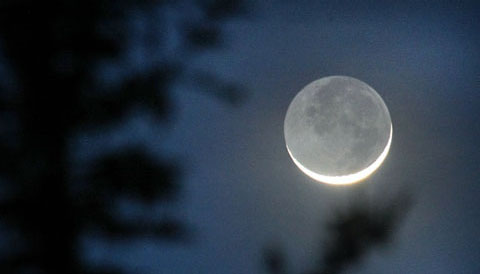
Bob King
This week's crescent Moon offers more than two horns to hang your hat on. Take a close look, and you'll see an entire circle of moonlight. Sunlight illuminates the bright crescent, but the remainder of the disk would be utterly black and invisible were it not for earthshine.
Often referred to as the "ashen light" or "the old Moon in the New Moon's arms," earthshine begins it lunar journey literally at your doorstep.
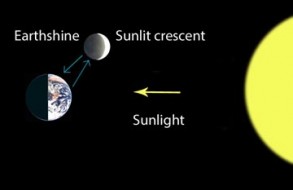
Bob King
Sunlight reflected from our planet radiates into space. A portion of it passes the Moon, strikes the lunar surface, and reflects back to our eyes. Much of that light is absorbed by the charcoal-dark lunar soil, which is why the earthlit Moon appears faint. From the surface of the Moon, ground illumination would resemble deep twilight here on Earth. By comparison, the bright crescent is illuminated by direct sunlight.
As the Moon waxes in phase, sunlight crawls across more and more of the darkened lunar landscape in our view. At full Moon, the entire Earth-facing side of our satellite is basking by sunlight. During the Moon's waning phases, earthlight increases as sunlight withdraws.
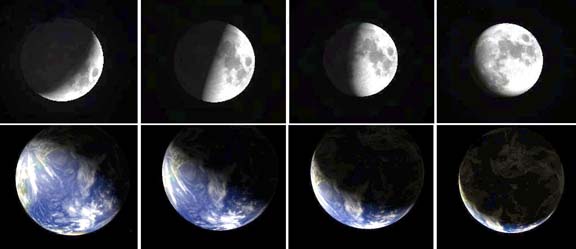
Source: Stellarium
Because the Moon and Earth's phases are complementary, Earth's phase (as seen from the Moon) always corresponds to the portion of the Moon that we see illuminated by earthshine. So earthshine is brightest when the lunar crescent is skinniest, in the days just after or before new Moon.
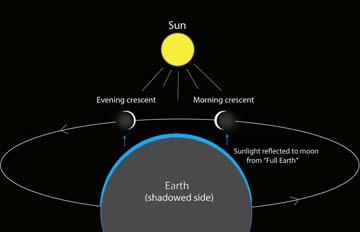
Bob King
Think the "Supermoon" is a big deal? An astronaut looking back at a "full Earth" would see an orb nearly four times the full Moon's apparent diameter and 50 times brighter!
This immediately suggests a challenge. How long can you keep earthshine in view? By the time the waxing crescent Moon is 4 days old, Earth's in gibbous phase (from a lunar perspective) and fading. At first quarter, a "half-Earth" lights the lunar sky and then dwindles to a crescent around the time of Full Moon.
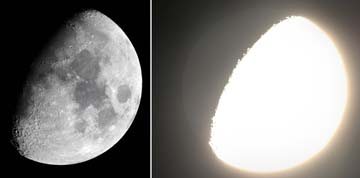
Bob King
You should be able to follow earthshine up to 5 days past new with the unaided eye and a few days beyond that when viewing through binoculars or a telescope. As the Moon waxes, not only is the Earth getting dimmer from a lunar perspective, but the area lit by our planet is also shrinking. My personal record is 9 days past new with a 10-inch telescope. I bet you can beat it. Hint: Keep the sunlit portion of the Moon out of the field of view.
Sightseeing in the Lunar Darkness
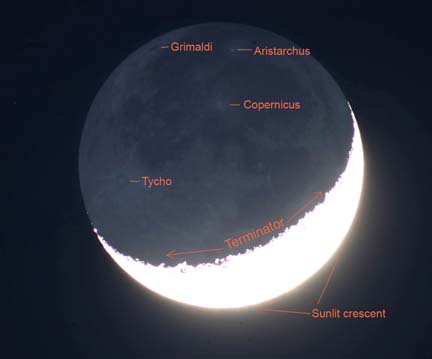
Bob King
One of the lesser appreciated aspects of lunar observing is exploring the dusky moonscape with binoculars or a telescope. There's much to see. Binoculars show a half dozen or more lunar seas, and the bright-rayed crater Tycho is an easy catch. Through a telescope you'll feel like you're hunting creatures that only come out after dark. Try it sometime for a whole new perspective.
While you can see earthshine anytime a crescent is present, northern hemisphere observers see it best in autumn morning twilight or spring evening twilight, because the lunar crescent stands high in the sky. Spring is also when earthshine is intrinsically brightest according to the Project Earthshine study conducted by Big Bear Solar Observatory and the California Institute of Technology.
Because the brightness of earthshine depends primarily on Earth's cloud cover, variations in its intensity can help us understand changes in our planet's climate. The study indicates a possible drop in Earth's overall reflectivity between 1994 and 1998, followed by a distinct jump (about 0.5%) from late 1998 through mid-2000. These changes might be correlated with the rise solar maximum, but the Sun's output varies by only about 0.1% during its 11-year-long activity cycle. A related paper describes day-to-day changes in brightness (about 5%) due to large-scale weather changes. Amazing stuff!
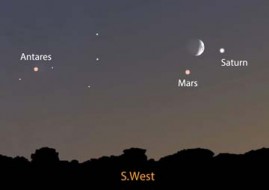
Source: Stellarium
Earth and Moon share ancient ties. According to prevailing theory, the Moon originated in a catastrophic collision between a Mars-sized planet and the infant Earth 4.5 billion years ago. Chunks of our planet's crust were blasted into orbit and later coalesced as our one and only natural satellite. Seeing Earth's reflection as we hold the Moon in our gaze reminds us of the deep connections between our two worlds.
Want to explore the Moon up close, really close? Check out Sky & Telescope's terrific new lunar globes. Choose either the natural-hued Moon you see by eye or the color-coded topographic version.
 1
1









Comments
Peter Wilson
August 28, 2014 at 10:08 am
Also, with a mid-sized telescope, if you move the sunlit portion of the Moon out of the field-of-view, you can see that the Earthshine is blue. We all know Earth is a blue planet, but when you see the blue in its reflected light, you can experience its blueness.
You must be logged in to post a comment.
You must be logged in to post a comment.